Designing Inclusive Lesson Plans: Assessment and Communication Skills
VerifiedAdded on 2023/06/14
|21
|5437
|250
Report
AI Summary
This report provides a comprehensive overview of lesson planning, emphasizing the importance of incorporating learning styles, assessment methods, and communication skills to create inclusive and effective learning environments. It analyzes the aim and characteristics of lesson plans, explores learning styles and taxonomies like Bloom's, and details how to design lesson plans that meet the diverse needs of learners. The report also discusses the significance of flexibility and adaptability in lesson plan design and how it impacts inclusive teaching. Furthermore, it defines assessment and evaluation, analyzes different assessment methods, and explains the use of differentiated assessment to cater to individual learner needs. Finally, it highlights how the analysis of assessment and evaluation results can inform and improve future lesson planning, ensuring continuous improvement in teaching practices.
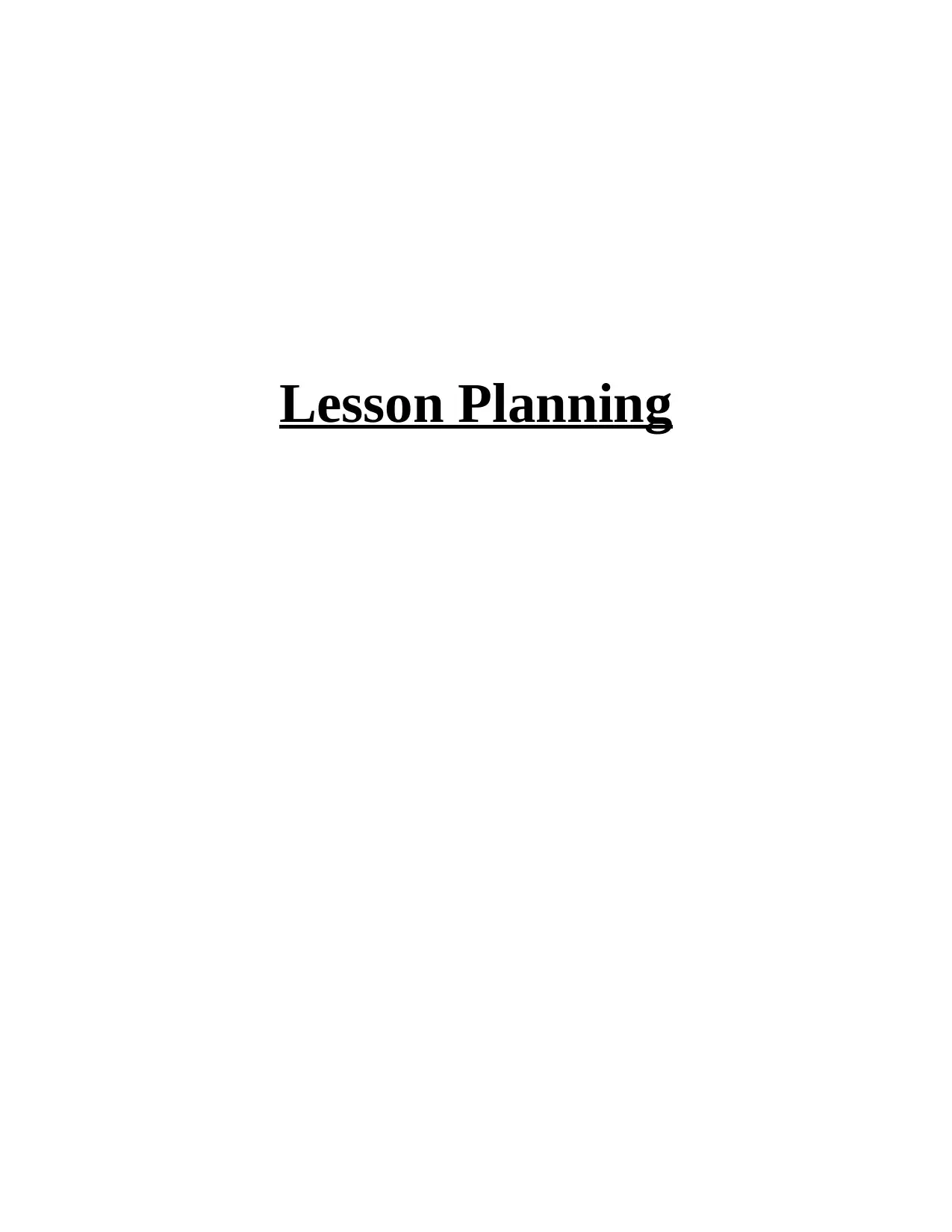
Lesson Planning
Paraphrase This Document
Need a fresh take? Get an instant paraphrase of this document with our AI Paraphraser
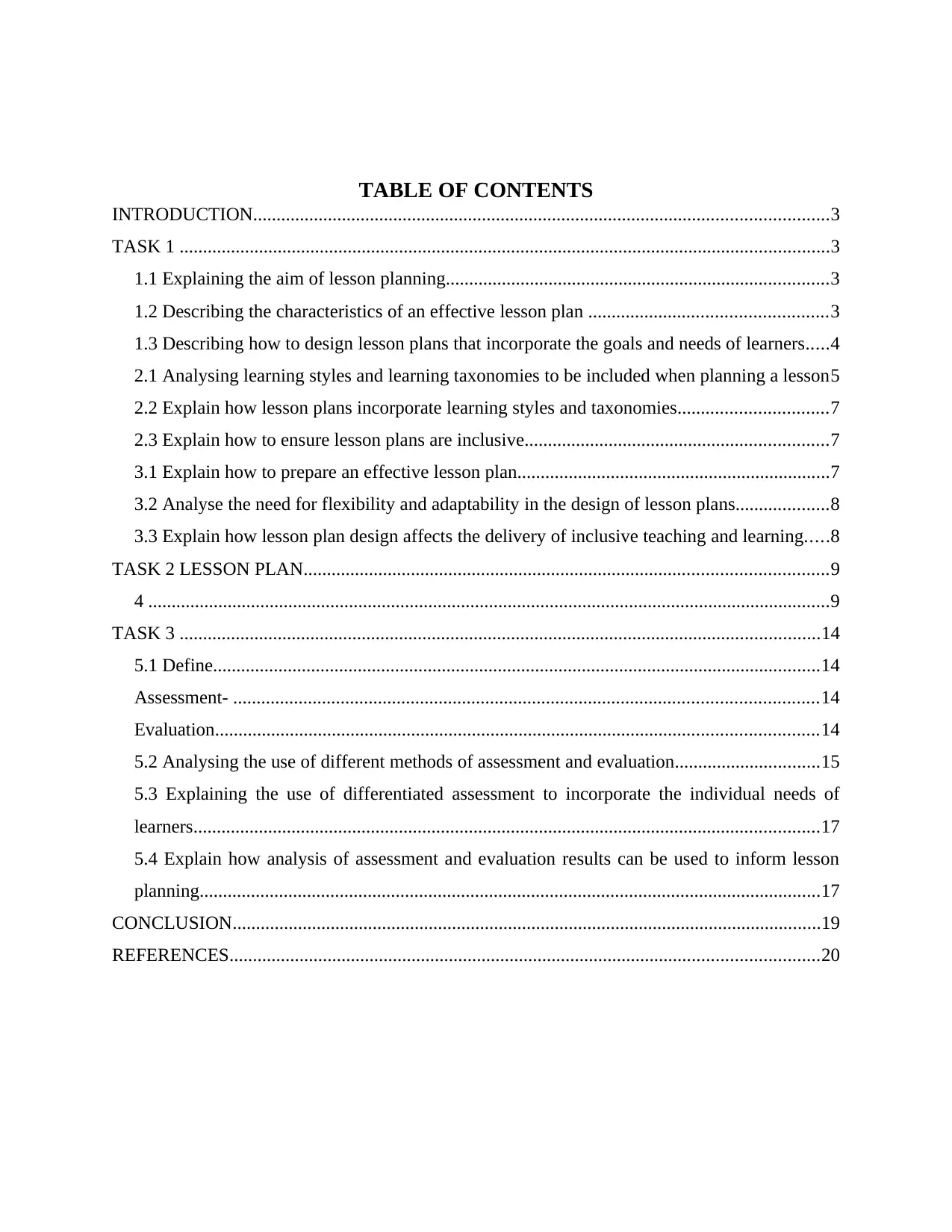
TABLE OF CONTENTS
INTRODUCTION...........................................................................................................................3
TASK 1 ...........................................................................................................................................3
1.1 Explaining the aim of lesson planning..................................................................................3
1.2 Describing the characteristics of an effective lesson plan ...................................................3
1.3 Describing how to design lesson plans that incorporate the goals and needs of learners.....4
2.1 Analysing learning styles and learning taxonomies to be included when planning a lesson5
2.2 Explain how lesson plans incorporate learning styles and taxonomies................................7
2.3 Explain how to ensure lesson plans are inclusive.................................................................7
3.1 Explain how to prepare an effective lesson plan...................................................................7
3.2 Analyse the need for flexibility and adaptability in the design of lesson plans....................8
3.3 Explain how lesson plan design affects the delivery of inclusive teaching and learning.....8
TASK 2 LESSON PLAN................................................................................................................9
4 ..................................................................................................................................................9
TASK 3 .........................................................................................................................................14
5.1 Define..................................................................................................................................14
Assessment- .............................................................................................................................14
Evaluation.................................................................................................................................14
5.2 Analysing the use of different methods of assessment and evaluation...............................15
5.3 Explaining the use of differentiated assessment to incorporate the individual needs of
learners......................................................................................................................................17
5.4 Explain how analysis of assessment and evaluation results can be used to inform lesson
planning.....................................................................................................................................17
CONCLUSION..............................................................................................................................19
REFERENCES..............................................................................................................................20
INTRODUCTION...........................................................................................................................3
TASK 1 ...........................................................................................................................................3
1.1 Explaining the aim of lesson planning..................................................................................3
1.2 Describing the characteristics of an effective lesson plan ...................................................3
1.3 Describing how to design lesson plans that incorporate the goals and needs of learners.....4
2.1 Analysing learning styles and learning taxonomies to be included when planning a lesson5
2.2 Explain how lesson plans incorporate learning styles and taxonomies................................7
2.3 Explain how to ensure lesson plans are inclusive.................................................................7
3.1 Explain how to prepare an effective lesson plan...................................................................7
3.2 Analyse the need for flexibility and adaptability in the design of lesson plans....................8
3.3 Explain how lesson plan design affects the delivery of inclusive teaching and learning.....8
TASK 2 LESSON PLAN................................................................................................................9
4 ..................................................................................................................................................9
TASK 3 .........................................................................................................................................14
5.1 Define..................................................................................................................................14
Assessment- .............................................................................................................................14
Evaluation.................................................................................................................................14
5.2 Analysing the use of different methods of assessment and evaluation...............................15
5.3 Explaining the use of differentiated assessment to incorporate the individual needs of
learners......................................................................................................................................17
5.4 Explain how analysis of assessment and evaluation results can be used to inform lesson
planning.....................................................................................................................................17
CONCLUSION..............................................................................................................................19
REFERENCES..............................................................................................................................20
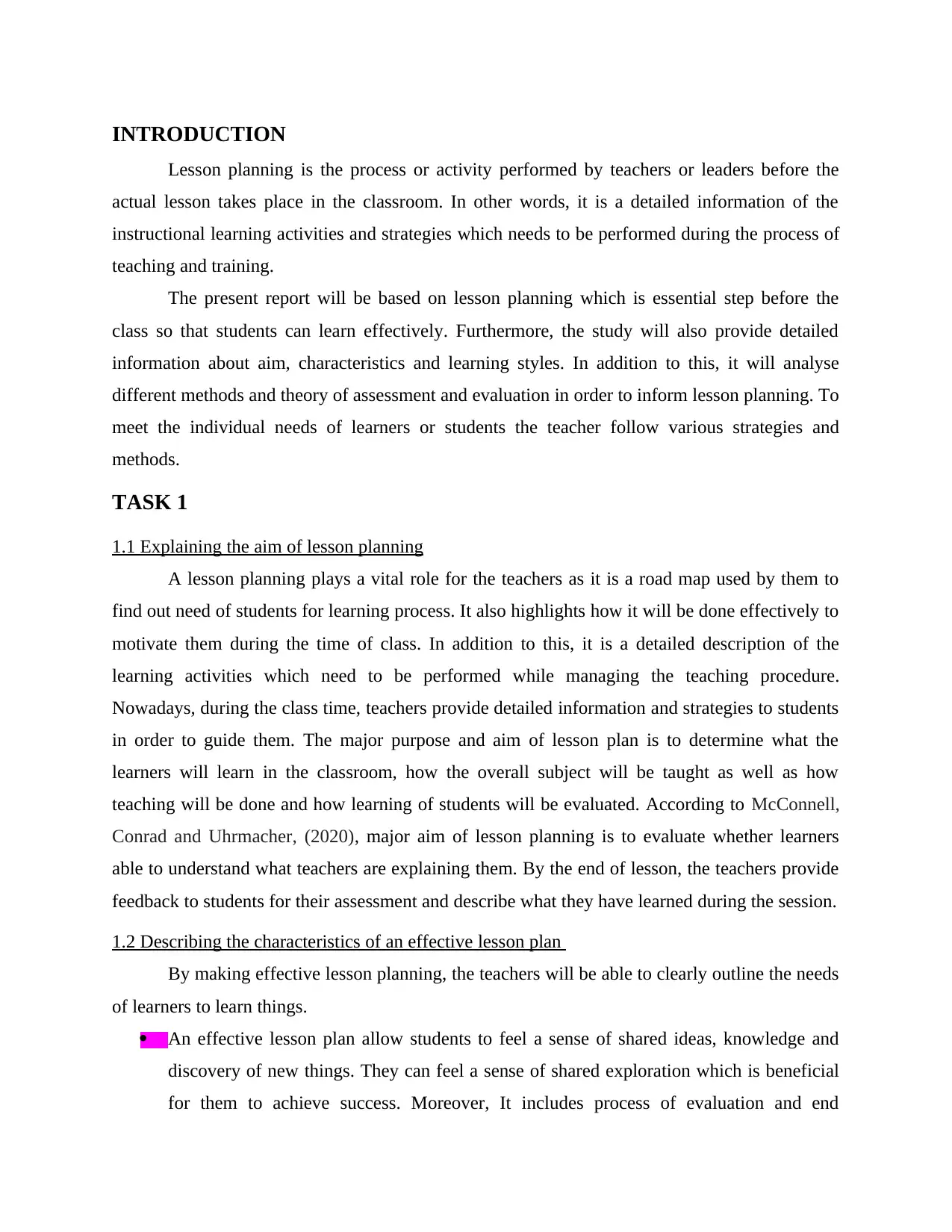
INTRODUCTION
Lesson planning is the process or activity performed by teachers or leaders before the
actual lesson takes place in the classroom. In other words, it is a detailed information of the
instructional learning activities and strategies which needs to be performed during the process of
teaching and training.
The present report will be based on lesson planning which is essential step before the
class so that students can learn effectively. Furthermore, the study will also provide detailed
information about aim, characteristics and learning styles. In addition to this, it will analyse
different methods and theory of assessment and evaluation in order to inform lesson planning. To
meet the individual needs of learners or students the teacher follow various strategies and
methods.
TASK 1
1.1 Explaining the aim of lesson planning
A lesson planning plays a vital role for the teachers as it is a road map used by them to
find out need of students for learning process. It also highlights how it will be done effectively to
motivate them during the time of class. In addition to this, it is a detailed description of the
learning activities which need to be performed while managing the teaching procedure.
Nowadays, during the class time, teachers provide detailed information and strategies to students
in order to guide them. The major purpose and aim of lesson plan is to determine what the
learners will learn in the classroom, how the overall subject will be taught as well as how
teaching will be done and how learning of students will be evaluated. According to McConnell,
Conrad and Uhrmacher, (2020), major aim of lesson planning is to evaluate whether learners
able to understand what teachers are explaining them. By the end of lesson, the teachers provide
feedback to students for their assessment and describe what they have learned during the session.
1.2 Describing the characteristics of an effective lesson plan
By making effective lesson planning, the teachers will be able to clearly outline the needs
of learners to learn things.
An effective lesson plan allow students to feel a sense of shared ideas, knowledge and
discovery of new things. They can feel a sense of shared exploration which is beneficial
for them to achieve success. Moreover, It includes process of evaluation and end
Lesson planning is the process or activity performed by teachers or leaders before the
actual lesson takes place in the classroom. In other words, it is a detailed information of the
instructional learning activities and strategies which needs to be performed during the process of
teaching and training.
The present report will be based on lesson planning which is essential step before the
class so that students can learn effectively. Furthermore, the study will also provide detailed
information about aim, characteristics and learning styles. In addition to this, it will analyse
different methods and theory of assessment and evaluation in order to inform lesson planning. To
meet the individual needs of learners or students the teacher follow various strategies and
methods.
TASK 1
1.1 Explaining the aim of lesson planning
A lesson planning plays a vital role for the teachers as it is a road map used by them to
find out need of students for learning process. It also highlights how it will be done effectively to
motivate them during the time of class. In addition to this, it is a detailed description of the
learning activities which need to be performed while managing the teaching procedure.
Nowadays, during the class time, teachers provide detailed information and strategies to students
in order to guide them. The major purpose and aim of lesson plan is to determine what the
learners will learn in the classroom, how the overall subject will be taught as well as how
teaching will be done and how learning of students will be evaluated. According to McConnell,
Conrad and Uhrmacher, (2020), major aim of lesson planning is to evaluate whether learners
able to understand what teachers are explaining them. By the end of lesson, the teachers provide
feedback to students for their assessment and describe what they have learned during the session.
1.2 Describing the characteristics of an effective lesson plan
By making effective lesson planning, the teachers will be able to clearly outline the needs
of learners to learn things.
An effective lesson plan allow students to feel a sense of shared ideas, knowledge and
discovery of new things. They can feel a sense of shared exploration which is beneficial
for them to achieve success. Moreover, It includes process of evaluation and end
⊘ This is a preview!⊘
Do you want full access?
Subscribe today to unlock all pages.

Trusted by 1+ million students worldwide
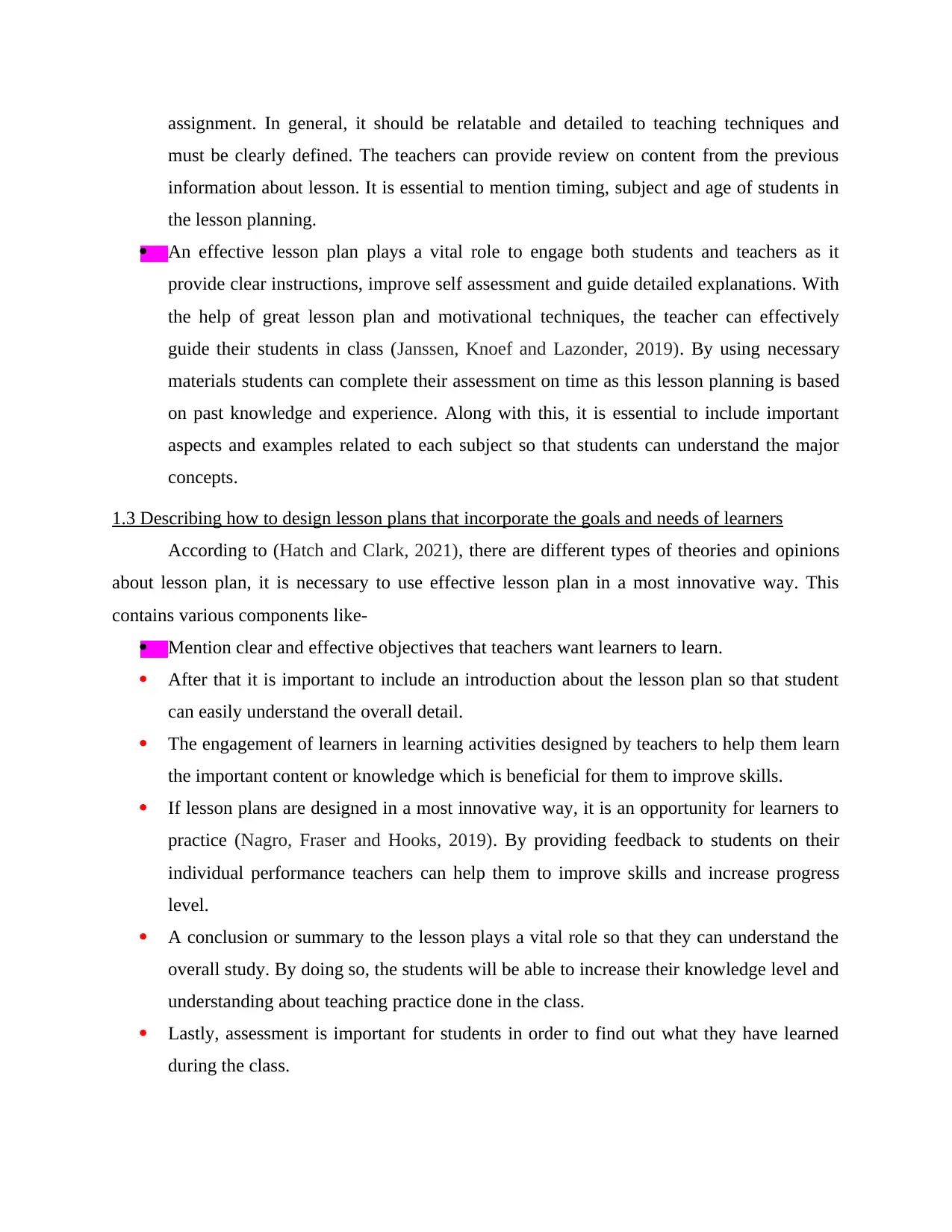
assignment. In general, it should be relatable and detailed to teaching techniques and
must be clearly defined. The teachers can provide review on content from the previous
information about lesson. It is essential to mention timing, subject and age of students in
the lesson planning.
An effective lesson plan plays a vital role to engage both students and teachers as it
provide clear instructions, improve self assessment and guide detailed explanations. With
the help of great lesson plan and motivational techniques, the teacher can effectively
guide their students in class (Janssen, Knoef and Lazonder, 2019). By using necessary
materials students can complete their assessment on time as this lesson planning is based
on past knowledge and experience. Along with this, it is essential to include important
aspects and examples related to each subject so that students can understand the major
concepts.
1.3 Describing how to design lesson plans that incorporate the goals and needs of learners
According to (Hatch and Clark, 2021), there are different types of theories and opinions
about lesson plan, it is necessary to use effective lesson plan in a most innovative way. This
contains various components like-
Mention clear and effective objectives that teachers want learners to learn.
After that it is important to include an introduction about the lesson plan so that student
can easily understand the overall detail.
The engagement of learners in learning activities designed by teachers to help them learn
the important content or knowledge which is beneficial for them to improve skills.
If lesson plans are designed in a most innovative way, it is an opportunity for learners to
practice (Nagro, Fraser and Hooks, 2019). By providing feedback to students on their
individual performance teachers can help them to improve skills and increase progress
level.
A conclusion or summary to the lesson plays a vital role so that they can understand the
overall study. By doing so, the students will be able to increase their knowledge level and
understanding about teaching practice done in the class.
Lastly, assessment is important for students in order to find out what they have learned
during the class.
must be clearly defined. The teachers can provide review on content from the previous
information about lesson. It is essential to mention timing, subject and age of students in
the lesson planning.
An effective lesson plan plays a vital role to engage both students and teachers as it
provide clear instructions, improve self assessment and guide detailed explanations. With
the help of great lesson plan and motivational techniques, the teacher can effectively
guide their students in class (Janssen, Knoef and Lazonder, 2019). By using necessary
materials students can complete their assessment on time as this lesson planning is based
on past knowledge and experience. Along with this, it is essential to include important
aspects and examples related to each subject so that students can understand the major
concepts.
1.3 Describing how to design lesson plans that incorporate the goals and needs of learners
According to (Hatch and Clark, 2021), there are different types of theories and opinions
about lesson plan, it is necessary to use effective lesson plan in a most innovative way. This
contains various components like-
Mention clear and effective objectives that teachers want learners to learn.
After that it is important to include an introduction about the lesson plan so that student
can easily understand the overall detail.
The engagement of learners in learning activities designed by teachers to help them learn
the important content or knowledge which is beneficial for them to improve skills.
If lesson plans are designed in a most innovative way, it is an opportunity for learners to
practice (Nagro, Fraser and Hooks, 2019). By providing feedback to students on their
individual performance teachers can help them to improve skills and increase progress
level.
A conclusion or summary to the lesson plays a vital role so that they can understand the
overall study. By doing so, the students will be able to increase their knowledge level and
understanding about teaching practice done in the class.
Lastly, assessment is important for students in order to find out what they have learned
during the class.
Paraphrase This Document
Need a fresh take? Get an instant paraphrase of this document with our AI Paraphraser
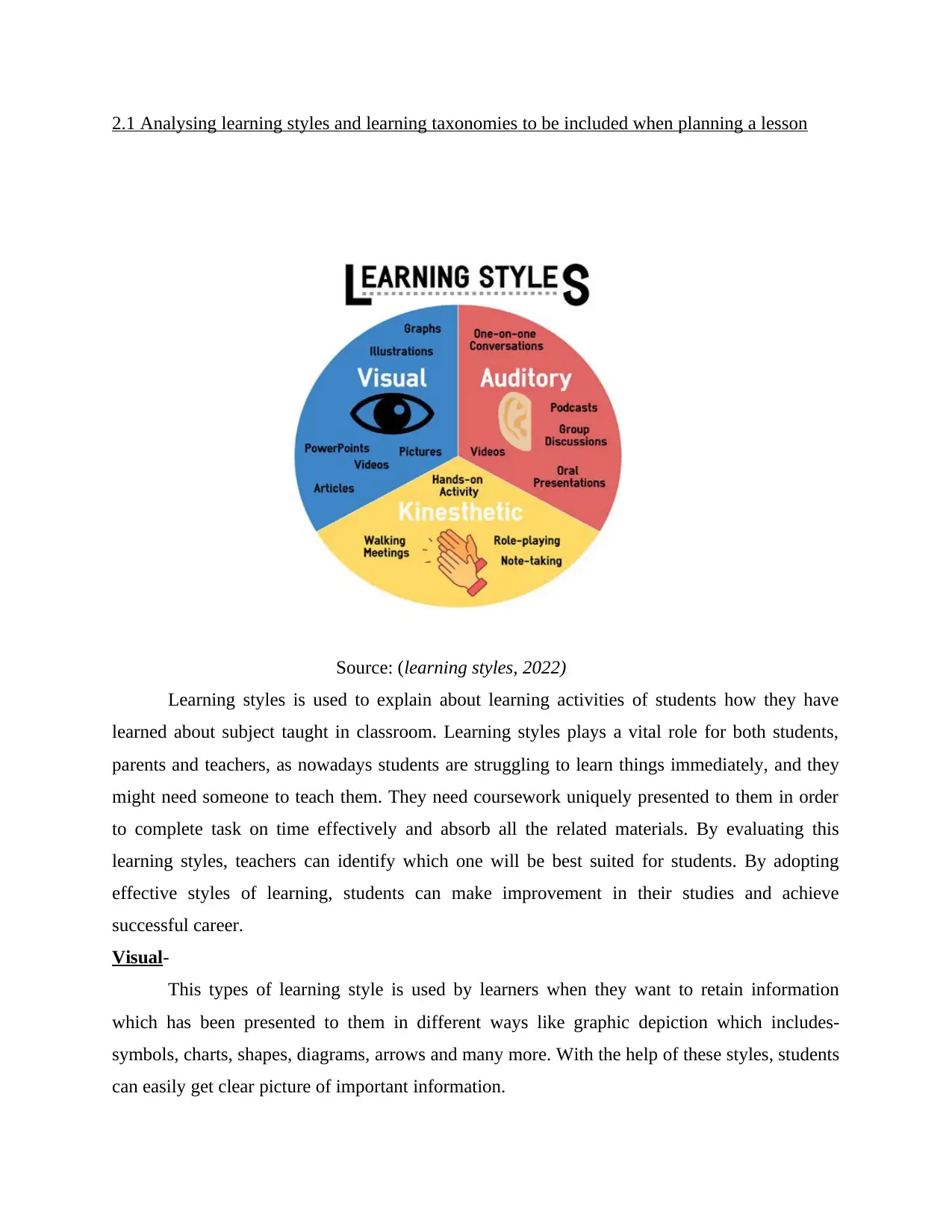
2.1 Analysing learning styles and learning taxonomies to be included when planning a lesson
Source: (learning styles, 2022)
Learning styles is used to explain about learning activities of students how they have
learned about subject taught in classroom. Learning styles plays a vital role for both students,
parents and teachers, as nowadays students are struggling to learn things immediately, and they
might need someone to teach them. They need coursework uniquely presented to them in order
to complete task on time effectively and absorb all the related materials. By evaluating this
learning styles, teachers can identify which one will be best suited for students. By adopting
effective styles of learning, students can make improvement in their studies and achieve
successful career.
Visual-
This types of learning style is used by learners when they want to retain information
which has been presented to them in different ways like graphic depiction which includes-
symbols, charts, shapes, diagrams, arrows and many more. With the help of these styles, students
can easily get clear picture of important information.
Source: (learning styles, 2022)
Learning styles is used to explain about learning activities of students how they have
learned about subject taught in classroom. Learning styles plays a vital role for both students,
parents and teachers, as nowadays students are struggling to learn things immediately, and they
might need someone to teach them. They need coursework uniquely presented to them in order
to complete task on time effectively and absorb all the related materials. By evaluating this
learning styles, teachers can identify which one will be best suited for students. By adopting
effective styles of learning, students can make improvement in their studies and achieve
successful career.
Visual-
This types of learning style is used by learners when they want to retain information
which has been presented to them in different ways like graphic depiction which includes-
symbols, charts, shapes, diagrams, arrows and many more. With the help of these styles, students
can easily get clear picture of important information.
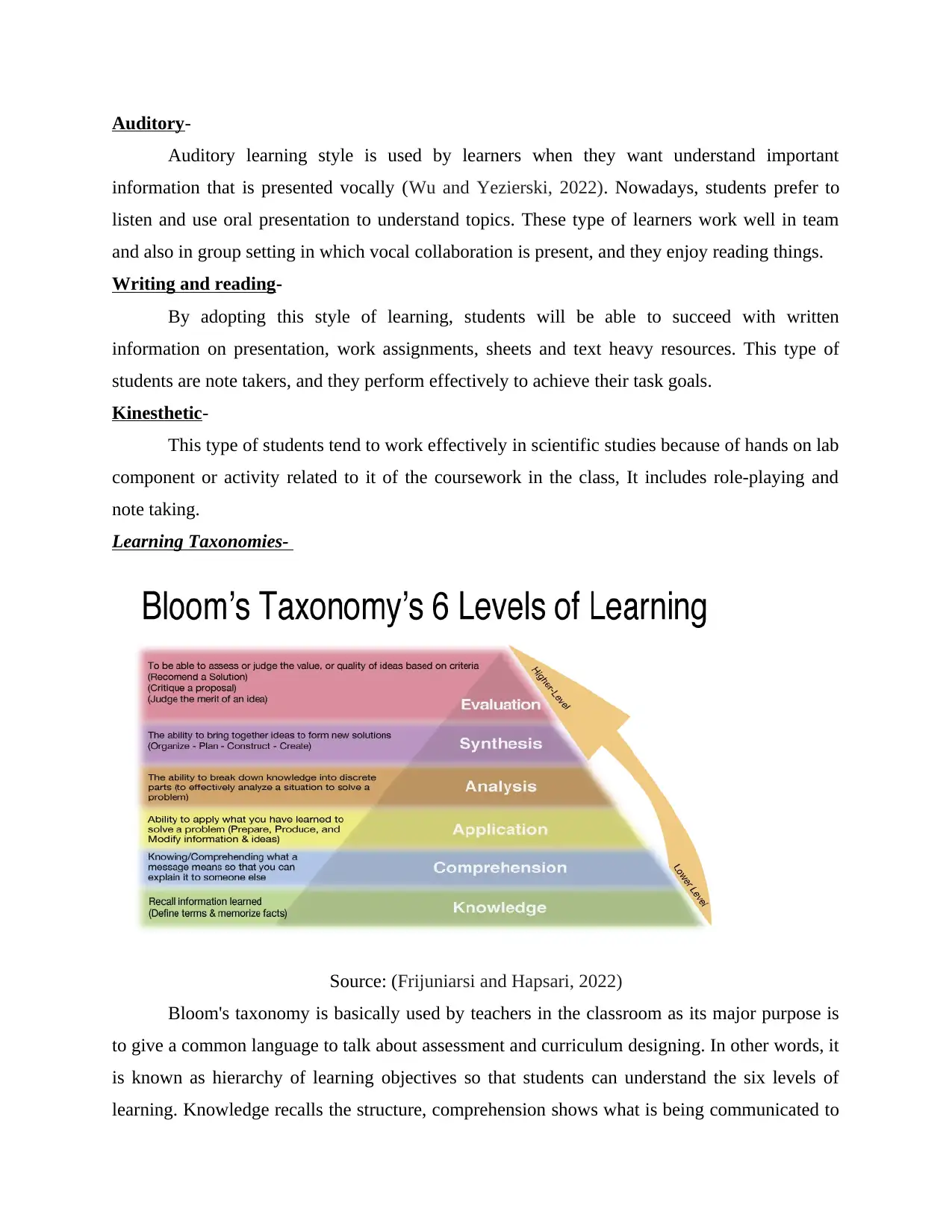
Auditory-
Auditory learning style is used by learners when they want understand important
information that is presented vocally (Wu and Yezierski, 2022). Nowadays, students prefer to
listen and use oral presentation to understand topics. These type of learners work well in team
and also in group setting in which vocal collaboration is present, and they enjoy reading things.
Writing and reading-
By adopting this style of learning, students will be able to succeed with written
information on presentation, work assignments, sheets and text heavy resources. This type of
students are note takers, and they perform effectively to achieve their task goals.
Kinesthetic-
This type of students tend to work effectively in scientific studies because of hands on lab
component or activity related to it of the coursework in the class, It includes role-playing and
note taking.
Learning Taxonomies-
Source: (Frijuniarsi and Hapsari, 2022)
Bloom's taxonomy is basically used by teachers in the classroom as its major purpose is
to give a common language to talk about assessment and curriculum designing. In other words, it
is known as hierarchy of learning objectives so that students can understand the six levels of
learning. Knowledge recalls the structure, comprehension shows what is being communicated to
Auditory learning style is used by learners when they want understand important
information that is presented vocally (Wu and Yezierski, 2022). Nowadays, students prefer to
listen and use oral presentation to understand topics. These type of learners work well in team
and also in group setting in which vocal collaboration is present, and they enjoy reading things.
Writing and reading-
By adopting this style of learning, students will be able to succeed with written
information on presentation, work assignments, sheets and text heavy resources. This type of
students are note takers, and they perform effectively to achieve their task goals.
Kinesthetic-
This type of students tend to work effectively in scientific studies because of hands on lab
component or activity related to it of the coursework in the class, It includes role-playing and
note taking.
Learning Taxonomies-
Source: (Frijuniarsi and Hapsari, 2022)
Bloom's taxonomy is basically used by teachers in the classroom as its major purpose is
to give a common language to talk about assessment and curriculum designing. In other words, it
is known as hierarchy of learning objectives so that students can understand the six levels of
learning. Knowledge recalls the structure, comprehension shows what is being communicated to
⊘ This is a preview!⊘
Do you want full access?
Subscribe today to unlock all pages.

Trusted by 1+ million students worldwide
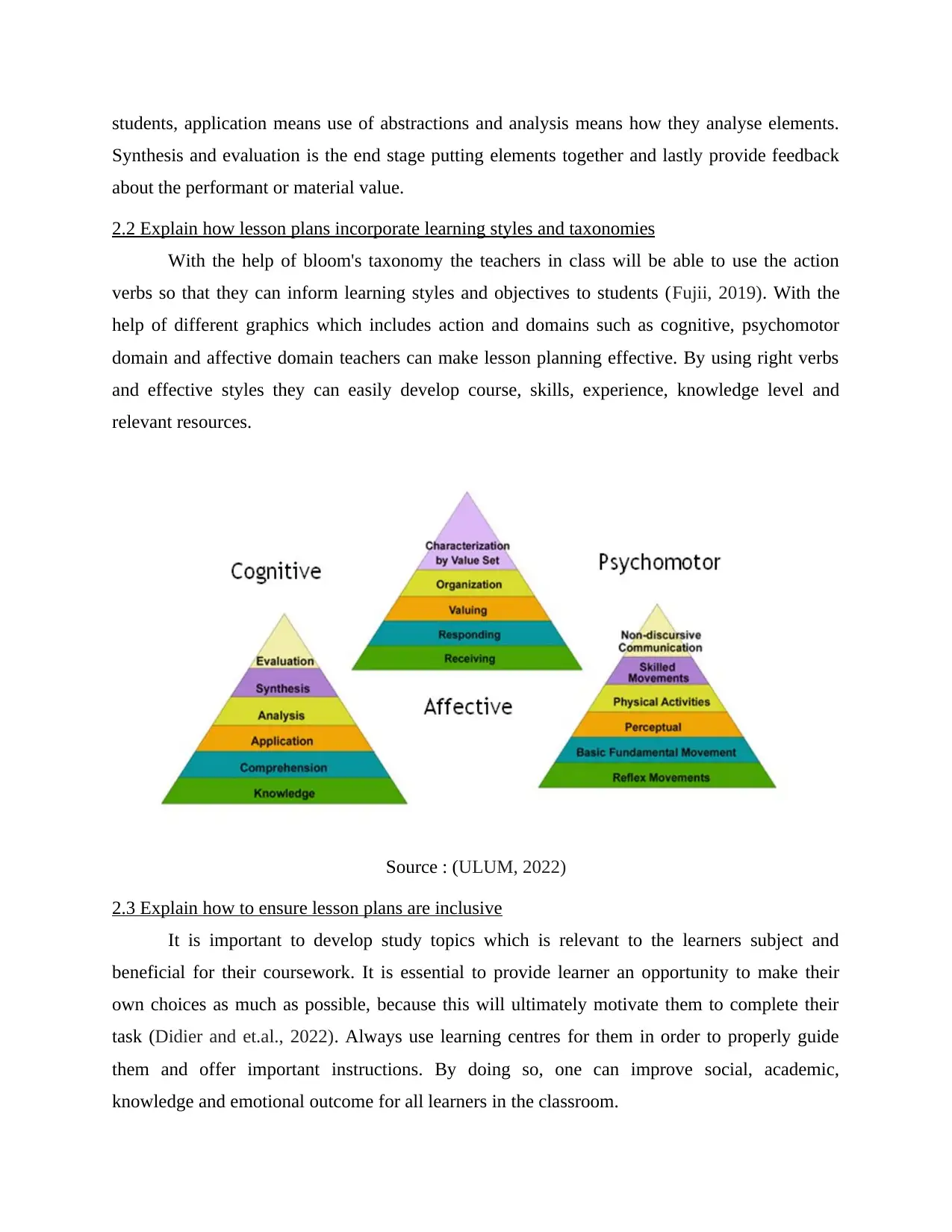
students, application means use of abstractions and analysis means how they analyse elements.
Synthesis and evaluation is the end stage putting elements together and lastly provide feedback
about the performant or material value.
2.2 Explain how lesson plans incorporate learning styles and taxonomies
With the help of bloom's taxonomy the teachers in class will be able to use the action
verbs so that they can inform learning styles and objectives to students (Fujii, 2019). With the
help of different graphics which includes action and domains such as cognitive, psychomotor
domain and affective domain teachers can make lesson planning effective. By using right verbs
and effective styles they can easily develop course, skills, experience, knowledge level and
relevant resources.
Source : (ULUM, 2022)
2.3 Explain how to ensure lesson plans are inclusive
It is important to develop study topics which is relevant to the learners subject and
beneficial for their coursework. It is essential to provide learner an opportunity to make their
own choices as much as possible, because this will ultimately motivate them to complete their
task (Didier and et.al., 2022). Always use learning centres for them in order to properly guide
them and offer important instructions. By doing so, one can improve social, academic,
knowledge and emotional outcome for all learners in the classroom.
Synthesis and evaluation is the end stage putting elements together and lastly provide feedback
about the performant or material value.
2.2 Explain how lesson plans incorporate learning styles and taxonomies
With the help of bloom's taxonomy the teachers in class will be able to use the action
verbs so that they can inform learning styles and objectives to students (Fujii, 2019). With the
help of different graphics which includes action and domains such as cognitive, psychomotor
domain and affective domain teachers can make lesson planning effective. By using right verbs
and effective styles they can easily develop course, skills, experience, knowledge level and
relevant resources.
Source : (ULUM, 2022)
2.3 Explain how to ensure lesson plans are inclusive
It is important to develop study topics which is relevant to the learners subject and
beneficial for their coursework. It is essential to provide learner an opportunity to make their
own choices as much as possible, because this will ultimately motivate them to complete their
task (Didier and et.al., 2022). Always use learning centres for them in order to properly guide
them and offer important instructions. By doing so, one can improve social, academic,
knowledge and emotional outcome for all learners in the classroom.
Paraphrase This Document
Need a fresh take? Get an instant paraphrase of this document with our AI Paraphraser
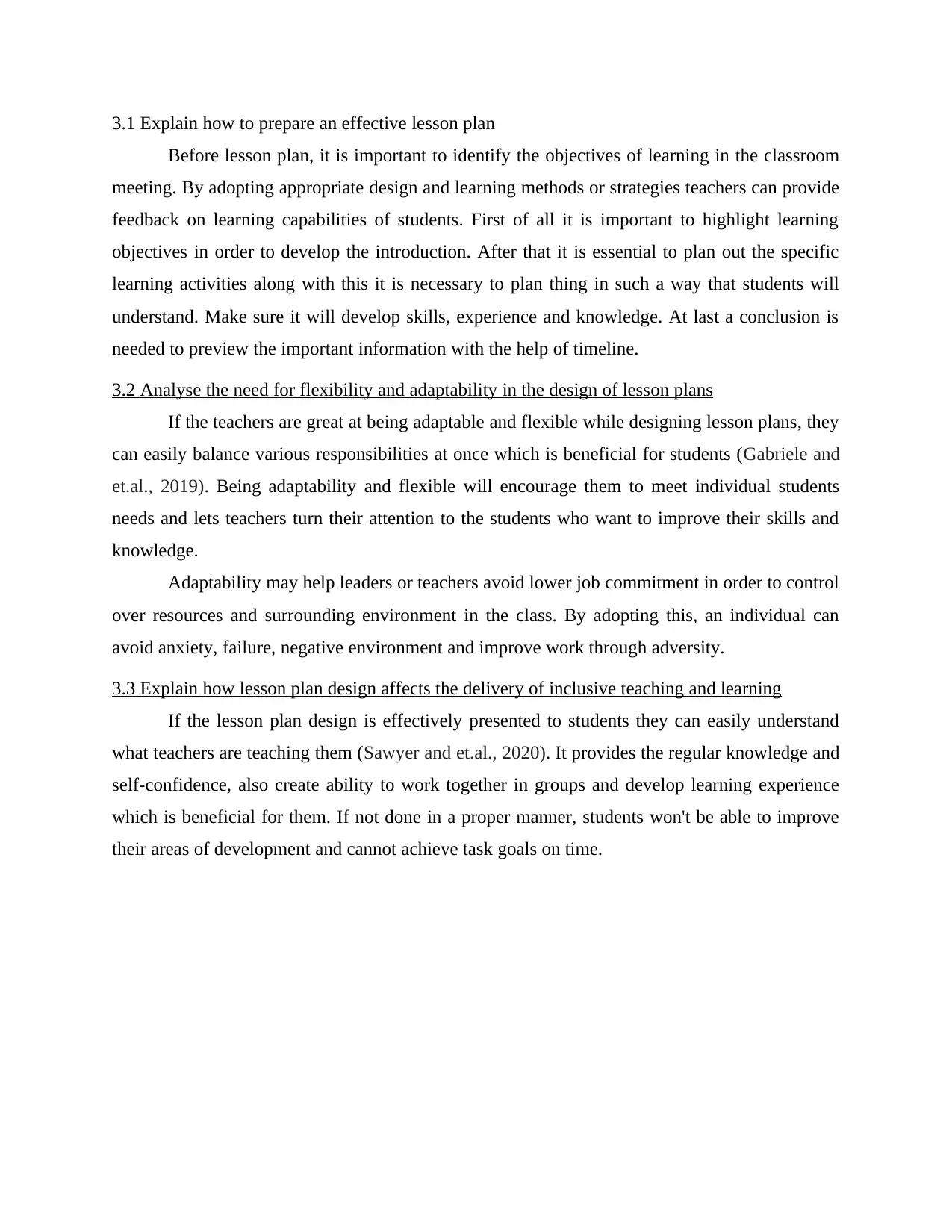
3.1 Explain how to prepare an effective lesson plan
Before lesson plan, it is important to identify the objectives of learning in the classroom
meeting. By adopting appropriate design and learning methods or strategies teachers can provide
feedback on learning capabilities of students. First of all it is important to highlight learning
objectives in order to develop the introduction. After that it is essential to plan out the specific
learning activities along with this it is necessary to plan thing in such a way that students will
understand. Make sure it will develop skills, experience and knowledge. At last a conclusion is
needed to preview the important information with the help of timeline.
3.2 Analyse the need for flexibility and adaptability in the design of lesson plans
If the teachers are great at being adaptable and flexible while designing lesson plans, they
can easily balance various responsibilities at once which is beneficial for students (Gabriele and
et.al., 2019). Being adaptability and flexible will encourage them to meet individual students
needs and lets teachers turn their attention to the students who want to improve their skills and
knowledge.
Adaptability may help leaders or teachers avoid lower job commitment in order to control
over resources and surrounding environment in the class. By adopting this, an individual can
avoid anxiety, failure, negative environment and improve work through adversity.
3.3 Explain how lesson plan design affects the delivery of inclusive teaching and learning
If the lesson plan design is effectively presented to students they can easily understand
what teachers are teaching them (Sawyer and et.al., 2020). It provides the regular knowledge and
self-confidence, also create ability to work together in groups and develop learning experience
which is beneficial for them. If not done in a proper manner, students won't be able to improve
their areas of development and cannot achieve task goals on time.
Before lesson plan, it is important to identify the objectives of learning in the classroom
meeting. By adopting appropriate design and learning methods or strategies teachers can provide
feedback on learning capabilities of students. First of all it is important to highlight learning
objectives in order to develop the introduction. After that it is essential to plan out the specific
learning activities along with this it is necessary to plan thing in such a way that students will
understand. Make sure it will develop skills, experience and knowledge. At last a conclusion is
needed to preview the important information with the help of timeline.
3.2 Analyse the need for flexibility and adaptability in the design of lesson plans
If the teachers are great at being adaptable and flexible while designing lesson plans, they
can easily balance various responsibilities at once which is beneficial for students (Gabriele and
et.al., 2019). Being adaptability and flexible will encourage them to meet individual students
needs and lets teachers turn their attention to the students who want to improve their skills and
knowledge.
Adaptability may help leaders or teachers avoid lower job commitment in order to control
over resources and surrounding environment in the class. By adopting this, an individual can
avoid anxiety, failure, negative environment and improve work through adversity.
3.3 Explain how lesson plan design affects the delivery of inclusive teaching and learning
If the lesson plan design is effectively presented to students they can easily understand
what teachers are teaching them (Sawyer and et.al., 2020). It provides the regular knowledge and
self-confidence, also create ability to work together in groups and develop learning experience
which is beneficial for them. If not done in a proper manner, students won't be able to improve
their areas of development and cannot achieve task goals on time.
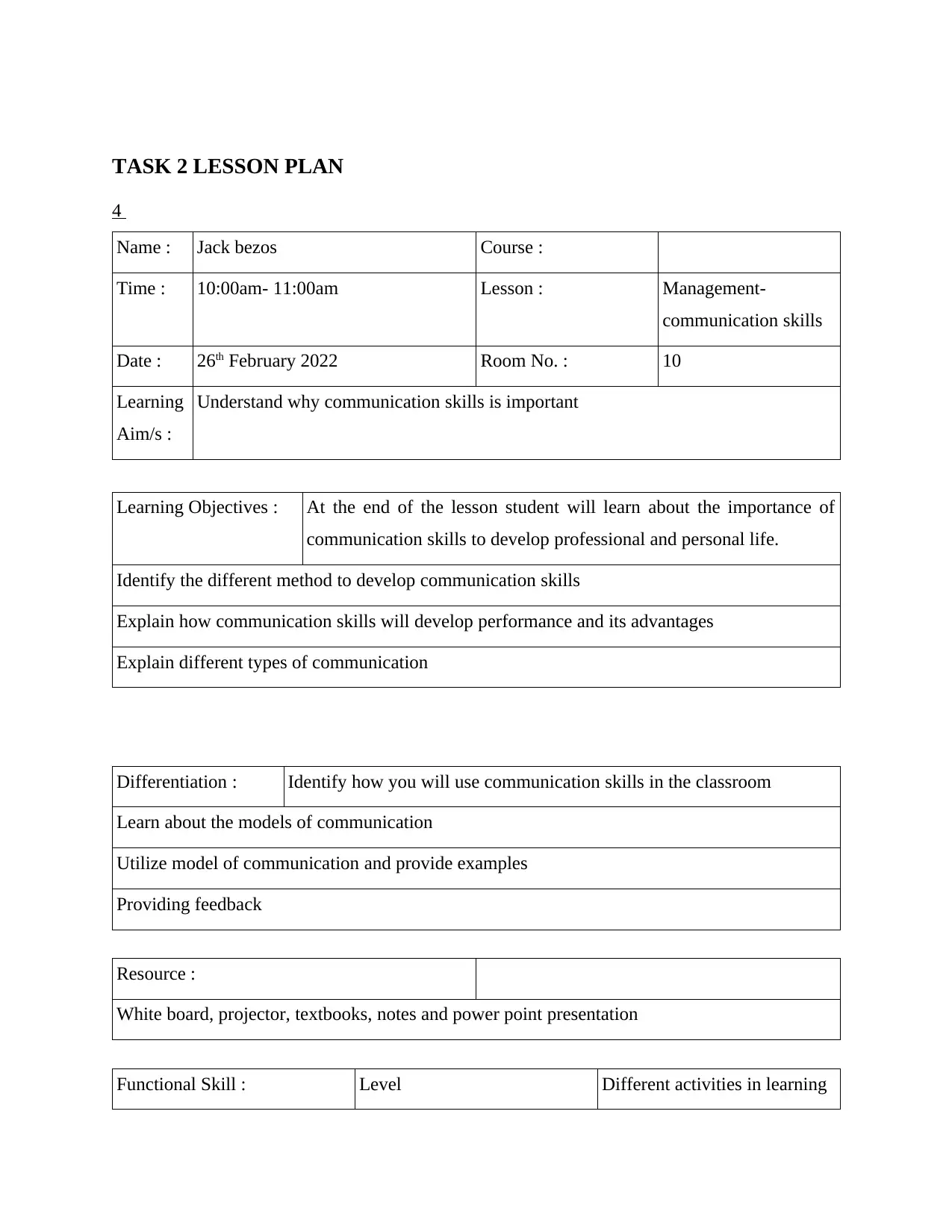
TASK 2 LESSON PLAN
4
Name : Jack bezos Course :
Time : 10:00am- 11:00am Lesson : Management-
communication skills
Date : 26th February 2022 Room No. : 10
Learning
Aim/s :
Understand why communication skills is important
Learning Objectives : At the end of the lesson student will learn about the importance of
communication skills to develop professional and personal life.
Identify the different method to develop communication skills
Explain how communication skills will develop performance and its advantages
Explain different types of communication
Differentiation : Identify how you will use communication skills in the classroom
Learn about the models of communication
Utilize model of communication and provide examples
Providing feedback
Resource :
White board, projector, textbooks, notes and power point presentation
Functional Skill : Level Different activities in learning
4
Name : Jack bezos Course :
Time : 10:00am- 11:00am Lesson : Management-
communication skills
Date : 26th February 2022 Room No. : 10
Learning
Aim/s :
Understand why communication skills is important
Learning Objectives : At the end of the lesson student will learn about the importance of
communication skills to develop professional and personal life.
Identify the different method to develop communication skills
Explain how communication skills will develop performance and its advantages
Explain different types of communication
Differentiation : Identify how you will use communication skills in the classroom
Learn about the models of communication
Utilize model of communication and provide examples
Providing feedback
Resource :
White board, projector, textbooks, notes and power point presentation
Functional Skill : Level Different activities in learning
⊘ This is a preview!⊘
Do you want full access?
Subscribe today to unlock all pages.

Trusted by 1+ million students worldwide
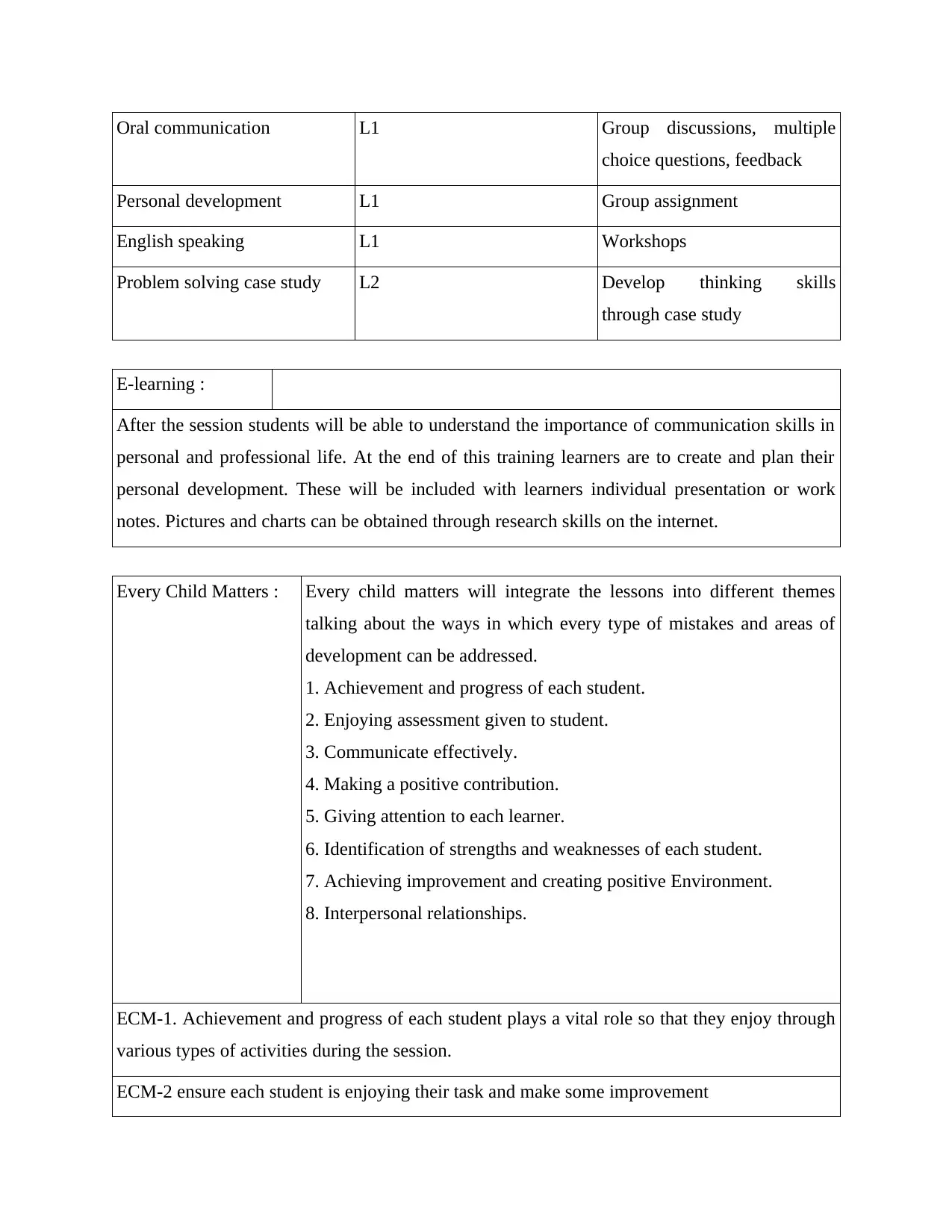
Oral communication L1 Group discussions, multiple
choice questions, feedback
Personal development L1 Group assignment
English speaking L1 Workshops
Problem solving case study L2 Develop thinking skills
through case study
E-learning :
After the session students will be able to understand the importance of communication skills in
personal and professional life. At the end of this training learners are to create and plan their
personal development. These will be included with learners individual presentation or work
notes. Pictures and charts can be obtained through research skills on the internet.
Every Child Matters : Every child matters will integrate the lessons into different themes
talking about the ways in which every type of mistakes and areas of
development can be addressed.
1. Achievement and progress of each student.
2. Enjoying assessment given to student.
3. Communicate effectively.
4. Making a positive contribution.
5. Giving attention to each learner.
6. Identification of strengths and weaknesses of each student.
7. Achieving improvement and creating positive Environment.
8. Interpersonal relationships.
ECM-1. Achievement and progress of each student plays a vital role so that they enjoy through
various types of activities during the session.
ECM-2 ensure each student is enjoying their task and make some improvement
choice questions, feedback
Personal development L1 Group assignment
English speaking L1 Workshops
Problem solving case study L2 Develop thinking skills
through case study
E-learning :
After the session students will be able to understand the importance of communication skills in
personal and professional life. At the end of this training learners are to create and plan their
personal development. These will be included with learners individual presentation or work
notes. Pictures and charts can be obtained through research skills on the internet.
Every Child Matters : Every child matters will integrate the lessons into different themes
talking about the ways in which every type of mistakes and areas of
development can be addressed.
1. Achievement and progress of each student.
2. Enjoying assessment given to student.
3. Communicate effectively.
4. Making a positive contribution.
5. Giving attention to each learner.
6. Identification of strengths and weaknesses of each student.
7. Achieving improvement and creating positive Environment.
8. Interpersonal relationships.
ECM-1. Achievement and progress of each student plays a vital role so that they enjoy through
various types of activities during the session.
ECM-2 ensure each student is enjoying their task and make some improvement
Paraphrase This Document
Need a fresh take? Get an instant paraphrase of this document with our AI Paraphraser
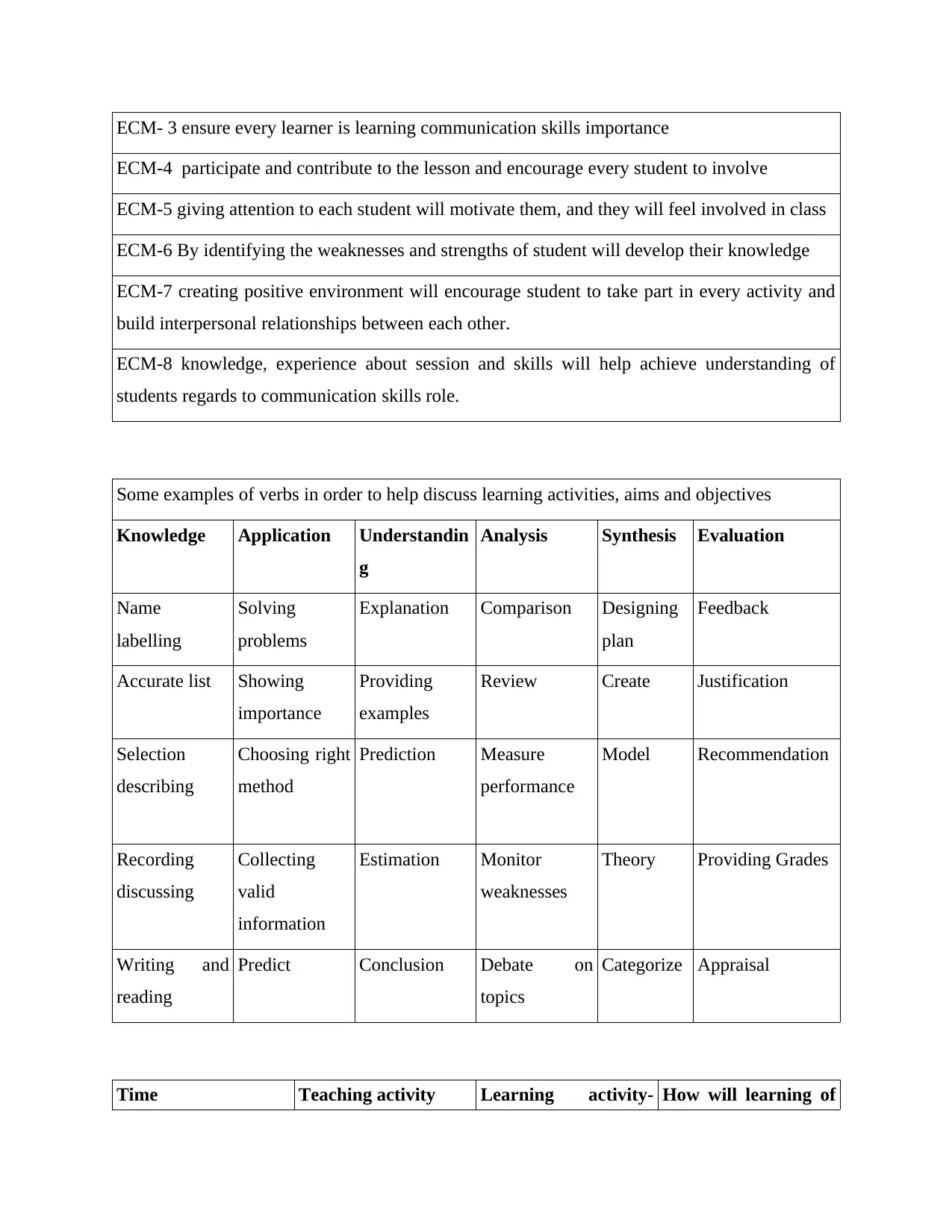
ECM- 3 ensure every learner is learning communication skills importance
ECM-4 participate and contribute to the lesson and encourage every student to involve
ECM-5 giving attention to each student will motivate them, and they will feel involved in class
ECM-6 By identifying the weaknesses and strengths of student will develop their knowledge
ECM-7 creating positive environment will encourage student to take part in every activity and
build interpersonal relationships between each other.
ECM-8 knowledge, experience about session and skills will help achieve understanding of
students regards to communication skills role.
Some examples of verbs in order to help discuss learning activities, aims and objectives
Knowledge Application Understandin
g
Analysis Synthesis Evaluation
Name
labelling
Solving
problems
Explanation Comparison Designing
plan
Feedback
Accurate list Showing
importance
Providing
examples
Review Create Justification
Selection
describing
Choosing right
method
Prediction Measure
performance
Model Recommendation
Recording
discussing
Collecting
valid
information
Estimation Monitor
weaknesses
Theory Providing Grades
Writing and
reading
Predict Conclusion Debate on
topics
Categorize Appraisal
Time Teaching activity Learning activity- How will learning of
ECM-4 participate and contribute to the lesson and encourage every student to involve
ECM-5 giving attention to each student will motivate them, and they will feel involved in class
ECM-6 By identifying the weaknesses and strengths of student will develop their knowledge
ECM-7 creating positive environment will encourage student to take part in every activity and
build interpersonal relationships between each other.
ECM-8 knowledge, experience about session and skills will help achieve understanding of
students regards to communication skills role.
Some examples of verbs in order to help discuss learning activities, aims and objectives
Knowledge Application Understandin
g
Analysis Synthesis Evaluation
Name
labelling
Solving
problems
Explanation Comparison Designing
plan
Feedback
Accurate list Showing
importance
Providing
examples
Review Create Justification
Selection
describing
Choosing right
method
Prediction Measure
performance
Model Recommendation
Recording
discussing
Collecting
valid
information
Estimation Monitor
weaknesses
Theory Providing Grades
Writing and
reading
Predict Conclusion Debate on
topics
Categorize Appraisal
Time Teaching activity Learning activity- How will learning of
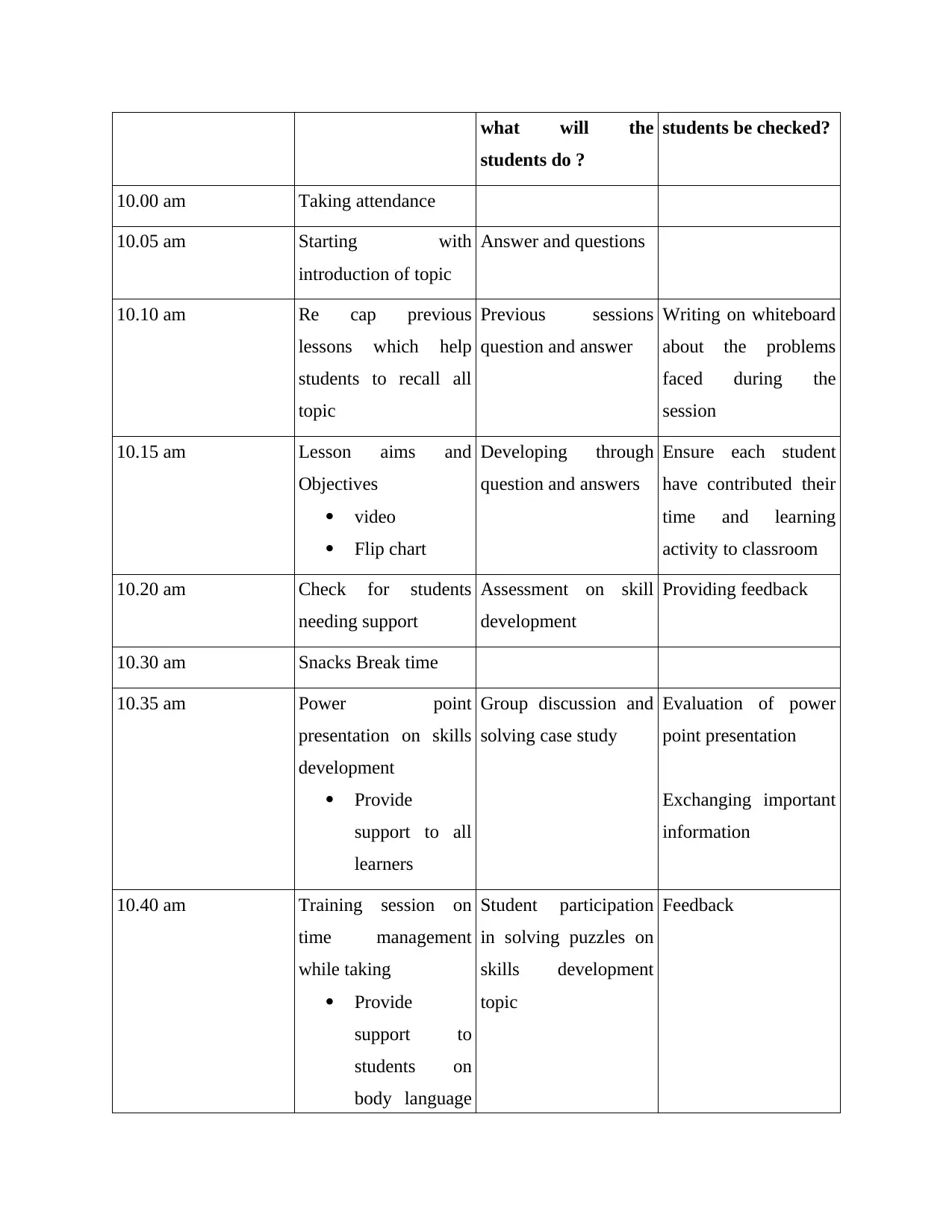
what will the
students do ?
students be checked?
10.00 am Taking attendance
10.05 am Starting with
introduction of topic
Answer and questions
10.10 am Re cap previous
lessons which help
students to recall all
topic
Previous sessions
question and answer
Writing on whiteboard
about the problems
faced during the
session
10.15 am Lesson aims and
Objectives
video
Flip chart
Developing through
question and answers
Ensure each student
have contributed their
time and learning
activity to classroom
10.20 am Check for students
needing support
Assessment on skill
development
Providing feedback
10.30 am Snacks Break time
10.35 am Power point
presentation on skills
development
Provide
support to all
learners
Group discussion and
solving case study
Evaluation of power
point presentation
Exchanging important
information
10.40 am Training session on
time management
while taking
Provide
support to
students on
body language
Student participation
in solving puzzles on
skills development
topic
Feedback
students do ?
students be checked?
10.00 am Taking attendance
10.05 am Starting with
introduction of topic
Answer and questions
10.10 am Re cap previous
lessons which help
students to recall all
topic
Previous sessions
question and answer
Writing on whiteboard
about the problems
faced during the
session
10.15 am Lesson aims and
Objectives
video
Flip chart
Developing through
question and answers
Ensure each student
have contributed their
time and learning
activity to classroom
10.20 am Check for students
needing support
Assessment on skill
development
Providing feedback
10.30 am Snacks Break time
10.35 am Power point
presentation on skills
development
Provide
support to all
learners
Group discussion and
solving case study
Evaluation of power
point presentation
Exchanging important
information
10.40 am Training session on
time management
while taking
Provide
support to
students on
body language
Student participation
in solving puzzles on
skills development
topic
Feedback
⊘ This is a preview!⊘
Do you want full access?
Subscribe today to unlock all pages.

Trusted by 1+ million students worldwide
1 out of 21
Related Documents
Your All-in-One AI-Powered Toolkit for Academic Success.
+13062052269
info@desklib.com
Available 24*7 on WhatsApp / Email
![[object Object]](/_next/static/media/star-bottom.7253800d.svg)
Unlock your academic potential
Copyright © 2020–2025 A2Z Services. All Rights Reserved. Developed and managed by ZUCOL.




